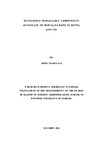| dc.description.abstract | Competitive advantage is the heart of a firm's performance in competitive market. It is, in its very basic words, a position a firm occupies against its competitors. The objective of this study was to determine the strategies that Barclays Bank of Kenya (BBK) adopts to achieve sustainable competitive advantage. BBK has operated in Kenya for 95 years and it remains the biggest bank in the country in terms of asset base, capitalization and profitability. It has built a strong brand name, and continues to be a leading and dominant bank in Kenya. It was therefore of interest to study and find out, the strategies it adopts to remain a top bank throughout the years. This would therefore be useful to scholars and policy makers.
This study was conducted using a case study design to gain in-depth knowledge.Primary data was collected using a semi-structured interview guide administered through one on one interview. Secondary data was used to enrich understanding of the bank and the industry as a whole. Data was then analyzed using conceptual content analysis as presented through tables and figures. The respondents were the senior management staff of Barclays bank of Kenya.
The research findings reveal that Barclays bank has a clear drive for competitive advantage and is motivated by top management's vision of the firms' future.
To achieve the goal of competitive advantage, BBK offers value to its customers at a cost
that produces economic performance superior to rivals. BBK then defends this position from the competition to achieve high sustainable performance. In conclusion, with the dynamic business environment, organizations should undertake to align their strategies to the ever changing demands of external environment. All managerial tasks including resource allocation and organization design should be directed at building the firm's market position.
Most of the recommendations included in this report are not simply external prescriptive. This is because some were proposed by interviewees in the course of data collection. For instance, it has been highly recommended that Barclays Bank of Kenya needs to be more aggressive since the market is not a monopoly a before and competition is stiff. The company needs to address its inefficiencies and focus on product innovation to suit customer needs and wants. The greatest challenge by the bank was the increase in competition within the industry. | en_US |

